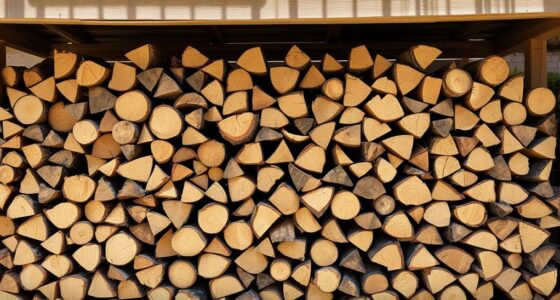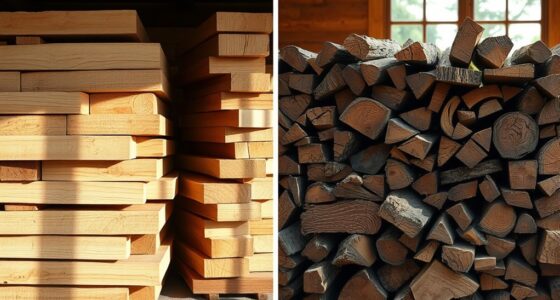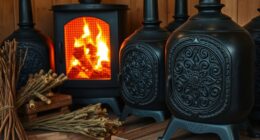Storing firewood outdoors keeps it dry and well-ventilated when you elevate it on racks or pallets, with a cover to protect from rain. Indoors, your logs stay protected from weather and pests but need good ventilation to prevent dampness. Both options have benefits and challenges—outdoors offers natural airflow, while indoors offers pest control. To optimize your storage setup and prevent issues, keep exploring the best techniques for each method.
Key Takeaways
- Outdoor storage promotes airflow, keeps firewood dry, and reduces pest risks with elevation and good ventilation.
- Indoor storage offers protection from weather but requires proper ventilation to prevent humidity buildup.
- Both methods benefit from covering the top to shield from rain and snow while leaving sides open for airflow.
- Proper stacking and regular inspection are essential indoors and outdoors to prevent pests and decay.
- Indoor storage is suitable for convenience and pest control, while outdoor storage is ideal for large quantities and cost-effectiveness.

Have you ever wondered how to keep your firewood dry and ready for use? Proper storage is essential to guarantee your wood burns efficiently and safely. Whether you choose to store your firewood indoors or outdoors, moisture control is key. Wood that retains excess moisture won’t burn well, producing more smoke and less heat. It also shortens the lifespan of your firewood, making it less cost-effective. To prevent this, you need a storage method that encourages good airflow and keeps the wood dry. Outdoors, stacking your firewood off the ground on a rack or pallet is a smart move. Elevating the wood allows air to circulate freely around each piece, reducing moisture buildup and preventing mold or rot. Covering the top with a tarp or a specialized firewood cover keeps rain and snow from soaking the wood, but it’s important to leave the sides open to promote ventilation. Adequate airflow not only maintains moisture control but also discourages pests like insects or rodents from making a home among your logs. Pests are a common concern when storing firewood outside, especially if the wood is in contact with the ground or poorly ventilated. By stacking correctly and keeping your wood elevated, you create a less inviting environment for unwanted critters. Regularly checking your outdoor storage to remove any infested or decayed wood helps prevent pests from spreading to other stored logs or even your home. Additionally, proper stacking techniques are crucial for maximizing airflow and minimizing pest infestations. Using ventilation methods can further improve air circulation around your stored firewood, reducing moisture and pest risks. Incorporating moisture control strategies can help maintain ideal conditions and extend the quality of your firewood. On the other hand, indoor storage offers its own advantages and challenges. Storing firewood inside, such as in a basement or garage, keeps it protected from the weather, which is excellent for moisture control. However, indoor storage can lead to increased humidity levels, which might cause the wood to absorb moisture and develop mold or mildew if not managed properly. To avoid this, ensure your indoor space has good ventilation and isn’t overly damp. Using a dedicated firewood rack inside helps keep the logs organized and allows air to circulate around them. While indoor storage minimizes pest risks compared to outdoor setups, it’s still wise to regularly inspect the wood for signs of pests or decay. Pests can sometimes be attracted indoors if the environment is conducive, especially if the storage area isn’t well-maintained. Proper stacking, covering, and ventilation are your best tools for moisture control and pest prevention. Additionally, incorporating digital literacy programs can help seniors learn safe and effective ways to handle and store firewood, ensuring they stay warm and safe during colder months. Taking these precautions ensures your firewood stays in top condition, burns efficiently, and lasts longer, making your fires warmer and more enjoyable.
Frequently Asked Questions
What Are the Safety Considerations for Indoor Firewood Storage?
When storing firewood indoors, you should guarantee proper ventilation to prevent firewood mold growth and control pests like termites or beetles. Keep firewood away from your home’s main living areas to reduce fire hazards and pest spread. Use a raised, well-ventilated rack, and regularly inspect for signs of pests or mold. This helps maintain safe storage, reduces health risks, and keeps your firewood dry and pest-free.
How Does Moisture Affect Firewood Stored Outdoors?
Imagine you leave firewood outside in a damp area, and moisture condensation occurs on the logs after rain. This moisture promotes fungal growth, which can weaken the wood and create health risks. Outdoors, moisture causes wood to rot faster and increases the chances of mold development. To prevent this, keep firewood elevated and covered, and avoid storing it directly on the ground, reducing exposure to moisture and fungal growth.
Can Indoor Storage Cause Indoor Air Quality Issues?
Indoor storage can cause indoor air quality issues if not managed properly. You might notice wood-borne pests or mold growth developing in stored firewood, which can release spores and allergens into your home. Poor ventilation or excess moisture can worsen these problems, leading to respiratory issues or allergies. To prevent this, guarantee proper ventilation, keep firewood dry, and regularly inspect your stored wood to minimize indoor air quality concerns.
What Are the Best Materials for Outdoor Firewood Racks?
Think of your firewood rack as the backbone of your outdoor setup. Opt for durable materials like metal or treated wood that resist weather and pests. Metal racks are sturdy and low-maintenance, while treated wood blends naturally with outdoor surroundings. Avoid cheap, unprotected wood or plastic, which won’t stand up to the elements. Your choice of outdoor storage materials guarantees your firewood stays dry, pest-free, and ready when you need it.
How Often Should Firewood Be Rotated When Stored Indoors?
You should rotate indoor firewood every few months to guarantee proper seasonal rotation and pest prevention. By swapping out older wood for fresh, you reduce the risk of pests like insects or mold establishing themselves. Regularly moving your firewood also helps it dry evenly and maintains ideal moisture levels, making it safer and more efficient to burn. Keep an eye on your wood, and rotate it at least seasonally for best results.
Conclusion
Whether you choose to store your firewood indoors or outdoors, remember that proper storage protects, preserves, and prepares. Store it in a way that keeps it dry, ventilated, and accessible. Protect it from moisture, pests, and decay. Keep it neat, keep it safe, and keep it ready. Your firewood is more than just fuel—it’s warmth, comfort, and coziness waiting to be released. Choose wisely, store carefully, and enjoy the crackling glow of your fire all winter long.











